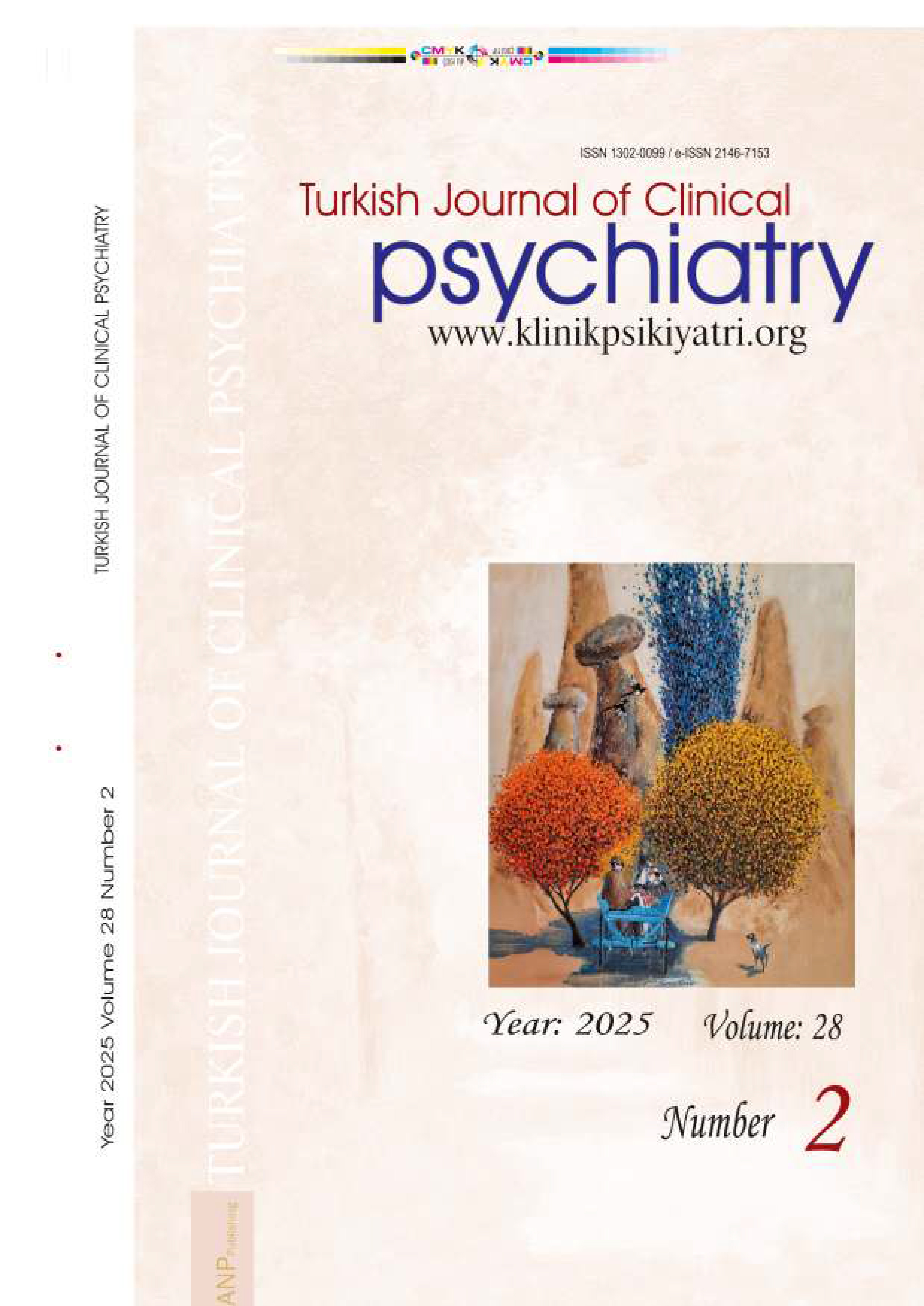





Volume: 15 Issue: 4 - 2012
| RESEARCH ARTICLE | |
| 1. | Traumatic Symptoms and Related Factors in Adolescents after a Friend's Death Ayşe Burcu Ayaz, Sebla Gökçe İmren, Muhammed Ayaz Pages 199 - 207 Objectives: In our study, it was aimed to evaluate the traumatic symptoms and related factors that are seen in the friends of a student who lost his life by an electric shock accident in the class. Method: A detailed form for sociodemografic characteristics, Child Posttraumatic Stress Reaction Index, Childhood Depression Inventory, and Adverse Life Events List were used for assessment of adolescents. Results: 219 adolescents between 15-19 years (mean 16.92±0.74) were participated in our study. Of the 219 adolescents we found that 32.7% had mild, 18.8% had moderate, 7.9% had severe, and 3% had very severe symptoms of post traumatic stress disorder, and that 10.9% had probable post traumatic stress disorder, and 9.3% had probable depression diagnoses. The frequency and severity of re-experiencing and hyperarousal symptoms were considerably high on Child Post- traumatic Stress Reaction Index. Adolescents had 2.49±2.74 (min-max: 0-17) adverse life events and the severity of traumatic symptoms were predicted by Adverse Life Events List and Childhood Depression Inventory total scores. Conclusion: Accidents have traumatic effects on adolescents. In our study, it's determined that traumatic symptoms which were seen after the accident were related to the adverse events experienced by adolescents, and the severity of depressive symptoms of the adolescents. Focusing on adverse life events and assessment of depressive symptoms in traumatized young people can prevent the development of traumatic symptoms. |
| 2. | Adaptation Study of Conners-Wells Self-Report Scale Revised Short Form to Turkish Adolescents Sema Kaner, Şener Büyüköztürk, Elvan İşeri Pages 208 - 217 Objectives: In this study, it is aimed to examine psychometric properties of the Conners-Wells Adolescent Self- Report Scale-Short (CASS-S) with Turkish adolescents. Methods: The subjects were 2822 adolescents aged 12- 17 years old and Confirmatory Factor Analysis-CFA was performed for their responses to CASS-S form. The structure validity of the scale was also investigated by the correlations between subscales and item analysis. Conners Adolescent Self-Report-Long (CASS-L), Conners Parent Rating Scale-Revised Short (CPRS-RS) and, Conners Teacher Rating Scale-Revised Short (CTRS-RS) were used to assess validity of the CASS-S. Internal reliability of CASS-S was measured with Cronbach's alpha coefficient. Test-retest reliability was also investigated. Results. Results of CFA suggested that CASS-S' structure derived from Turkish teachers were fit to the original structure of the CASS-S. Correlations between CASS-S and CASS-L, CTRS-RS, and CPRS-RS were from low to high (respectively, 0.28-0.83; 0.12-0.27, 0.20-0.66). Intercorrelations between subscales of the CASS-S were between 0.33- 0.74. Item analysis revealed that CASS-S was discriminate upper 27% group from lower 27% group significantly (p<0.00). Cronbach's alpha coefficient (0.60- 0.74), and test-retest reliability (0.74-0.80) was also investigated. Conclusion: It was concluded that besides the other information sources, the Turkish form of CASS- S is a valid and reliable instrument based on adolescents' reports and can be use to screen and assess adolescents who have conduct, attention, cognitive, and impulsive problems in Turkey. However, CASS-S' structure validity must be investigated on the adolescents with different types of ADHD and different psychiatric diagnosis. |
| 3. | Analyzing Suicide Attempts: Risk Factors and Follow Up Ali Emre Şevik, Halil Özcan, Emin Uysal Pages 218 - 225 Objectives: The aim of this study is to investigate the sociodemographic characteristics, psychiatric diagnosis and follow-up of suicide attempts, we purpose this study as guiding the implementation of long term social protection programs. Method: In this research participants admitted to Kastamonu State Hospital Crisis Intervention Unit with suicide attemption who were consulted to Psychiatry Outpatient Clinic and agreed to participate in the study between June 2008 and January 2010 were taken to the study. Sociodemographic data form including credentials, educational and occupational status, current and previous psychiatric disorders were applied to all participants. Results: A total of 193 patients received to study therewere 150 (%78) women and 43 (%22) men. While the groups age range, 14-56 years, mean age ranged from 24.6 ± 9.3 years. Most of the suicide attempts application is 26 people in August realized, 62 (32%) of the attempts have been observed in summer months. 13 (8%) of patients had suicide attempts in their family history. 79% of attempts were done by taking drugs. 49 (25%) of patients previously attempted suicide. 81 (42%) had one single interview in a psychiatry outpatient ward the others 112 (58%) had regular interviews. Conclusion: Women attempt suicide more than men is detected. During the summer months suicide attempts have been observed more frequently. Previous attemption to suicide having family history of suicide are detected as basic risk factors. |
| 4. | Factors Related to Marital Satisfaction and Views About Marital Therapy in Couples Applying for Marita! Therapy Mehmet Eskin Pages 226 - 237 Objectives: To investigate factors related to marital satisfaction and views about marital therapy in couples applying for treatment. Method: 34 couples filled in a questionnaire containing questions about sociodemo- graphic-clinical-marital features and participants' expectations from and their anticipated level of effort in marital therapy as well as measures of marital satisfaction, communication problems and mental health. Chi-square, t-test, Pearson product moment correlation coefficient and multiple regression analyses were used to analyze the data. Results: The success of marital therapy was estimated to be 66% and the amount of effort as 81%. While violent events decreased both men's and women's marital satisfaction, having child(ren) for men and marrying at an older age for women increased marital satisfaction. Spouses' negative behaviors in communication reduced men's and fear reduced women's marital satisfaction. While marital satisfaction increases men's perceived efficacy of marital therapy, attributing marital problems to their spouses decreases it. Fear in communication reduce women's perceived efficacy of marital therapy. Marital satisfaction increases men's anticipated level of effort in therapy. While perceived efficacy of treatment and attributing marital problems to husband increase women's anticipated levels of effort in therapy, having experienced marital violence decreases it. Conclusion: Violence, communication, age of marriage, having child(ren) or not, attribution of marital problems and marital satisfaction influence participants' perceptions of the efficacy of treatment and the anticipated levels of effort in therapy. Therefore, these factors should be taken into account for the assessment and treatment planning of persons applying for marital therapy. |
| 5. | Gender Differences in Subjective Thoughts of Schizophrenia Patients About Their Sexuality Basri Doğu, Jülide Güler, Serhat Çıtak, Yavuz Altunkaynak, Nihat Alpay Pages 238 - 247 Objectives: The aim of this study was to evaluate the relation of schizophrenic outpatients' subjective thoughts about their sexual functioning, The psychiatrists' attitudes about sexual function and sexual dysfunction of schizophrenic patients and sociodemographic variables of the patients'. Method: The study included a total of 120 patients, 63 females and 57 males, all diagnosed with schizophrenia but in remission according to DSM-IV diagnosis criteria. The patients filled out a socio-demographic survey form designed in order to evaluate the patients' subjective views of their sexual life and determine their medicinal use, in addition to other data. Results: 52.4% of female patients and 50.95 of male patients had reported regular sexual life. 52.4% of women and 38.6% of men told that they had have a problem in their sexual life. 46% of women and 49.1% of men considered that their sexual problems are due to their illness. But 84.1% of women and 78.9% of men have had no information about the influence of the illness and medications on their sexual funcions. 83.3% of the patient (88.9% of the women and 77.2% of the men) told that their psychiatrists' did not ask them about their sexual life or about their sexual problems, and also didn't informed them about that. Conclusion: This findings had shown us that the psychiatrists must give information to schizophrenic patients about safe and healthy sexual life and about the sexual side effects of the antipsychotic treatment. |
| 6. | Manic Episode with Psychotic Features in Patient with Parkinson's Disease Gonca Karakuş, Nurgül Özpoyraz, Meliha Zengin, Lut Tamam, Ayşe Vural, Filiz Koç Pages 248 - 251 Parkinson's disease is a chronic and progressive neurode- generative disease. Psychiatric symptoms and disorders are a common cooccurrence in people with Parkinson's disease. Psychiatric symptoms and disorders may be direct result of Parkinson's disease, its comorbid pathologies, or occur as a side effect of pharmacotherapy. Parkinson's disease is associated depression, anxiety, psychosis, sexual dysfunction, mania and dementia. Depression is the most common psychiatric complication in Parkinson's disease. Although depressive disorders are common, manic states are rare in Parkinson's disease. Underlying mechanisms are poorly understood and treatment options established in such dual diagnoses are not enough. Interactions between mood disorders and Parkinson's disease is not clear, or whether they might have a common origin. It seems that manic states are related to increased dopaminergic activity and usually appear in the "on" phases of Parkinson's disease. A 58 years old man who had manic attack with psychotic features in course of Parkinson's disease is presented in this report. Both Parkinson disease and its treatment could result in occurence of a mood disorder. This case report emphasizes the need to follow up these patients from this perspective and change their treatment accordingly. Parkinson disease patients with comorbid mood disorder could be succesfully treated with a combination of mood stabilizers and atypical antipsychotics that had low extrapiramidal side effects. Systematic follow up studies will bring us a clear vision of prognosis and treatment responce of such patients. |
| 7. | Selective Serotonin Reuptake Inhibitors and Galactorrhea: A Comparison of Sertraline and Citaiopram Based on a Case Report Sevilay Özcan, Lut Tamam, Ayçe Soydan Pages 252 - 254 Hyperprolactinemia and galactorrhea are very common in psychiatric patients because of the mechanism of action of antipsychotic drugs on dopamine receptors. This side effect could also appear during antidepressant treatment. Hyperprolactinemia has been reported to occur as a side effect during treatment with different types of antidepressants including tricyclic antidepressants, selective noradrenaline reuptake inhibitors, selective serotonin reuptake inhibitors (SSRI). In some case reports this side effect has been linked with the dosage of the medication used. Besides, galactorrhea due to SSRI usage has been proposed to be a result of direct stimulation of serotonin to prolactin release or indirect effect of serotonin as dopamine antagonist. In this paper we described case that has been using 50 mg sertralin per day for the treatment of her current mixed anxiety and depressive disorder episode. During her treatment, she complained about galactorrhea and prolactin elevation. She recovered from this adverse effect just after cessation of the sertralin. One week later she has been introduced another SSRI, citaiopram at a dose of 20 mg per day which resulted in total remission of her symptoms. In this case, we discussed two different medications which are believed to have same mechanism of action for depression globally, but display different effects on prolactin levels due to diversity of their other receptor interactions. Physicians should be aware of subtle differences in between SSRIs leading to different side effects and prescribe their drugs to the patients accordingly. |










